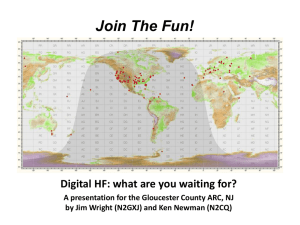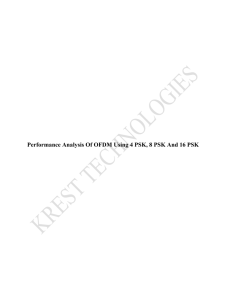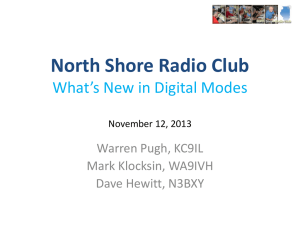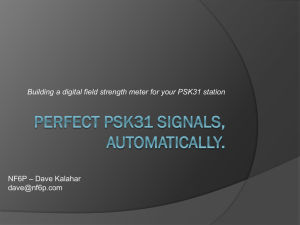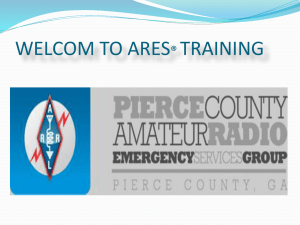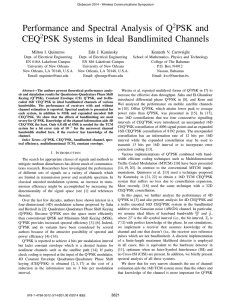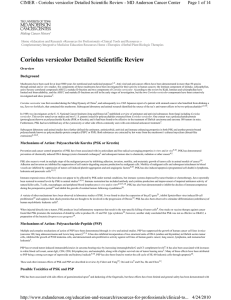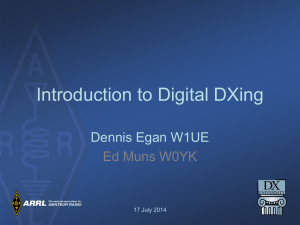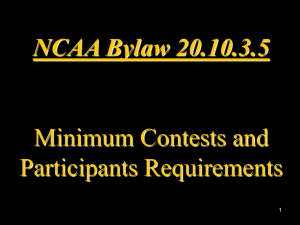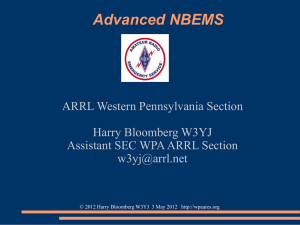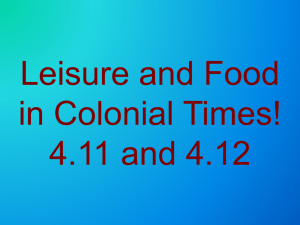PSK mode - Surrey Amateur Radio Club
advertisement
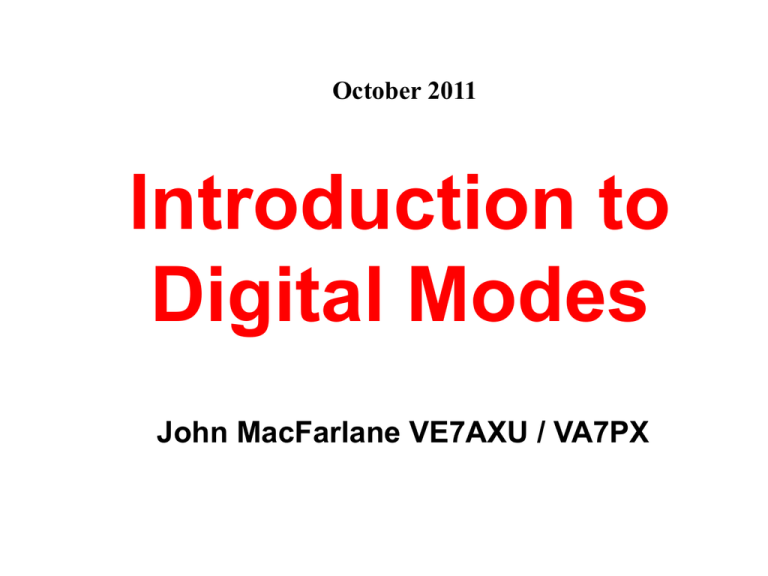
October 2011 Introduction to Digital Modes John MacFarlane VE7AXU / VA7PX Introduction • Getting on the air on HF can be intimidating for a new ham. • I am assuming that you have a licence and have HF priviledges • Go beyond using VHF on the repeater • Digital modes are a great way to get introduced to exciting on-air action with minimal investment. • Its my hope that hams who are not currently operating on HF will become active through these exciting modes. What Are Digital Signals? • Amateurs use an SSB Class-C transmitter to send and receive • They use a personal computer sound card to code and decode the signals (numerical values at a fixed rate) which create audio sounds. You can hear these signals on the air. • The basic element is the binary bit (0 or 1, on or off, plus or minus, yes or no, on or off) • Morse for example is on and off • Letters, numbers etc can be encoded using these techniques • Characters are coded so that each letter and number etc. has a unique code, which often takes at least five data bits and a synchronizing bit per character. Each RTTY character requires 7.5 bits – and at 45.45bps that sends 6 characters per second. • RTTY is sent at 60wpm • PSK31 is sent at 35wpm • MFSK16 is sent at 40wpm • Some modes use alphabets that have a variable number of bits per second. Morse or PSK modes frequently used characters with shorter sequences (eg. in morse “e” is one dit) 1 space 11 e 101 t 111 o 1011 a 1111 n ...... 1010101101 Z •By increasing the amount of bits it is possible to send hundreds of different characters (eg. useful for sending Japanese) •Signals are synchronized so that the receiver can tell when one letter ends and the next begins so a special serious of bits marks the end. •Noise on air can confuse the decoder losing the data – causing errors at the receiving end • In digital signals there are built in methods to allow errors to be automatically fixed, either by ... • the receiving station detecting the error and asking the sender to send again, (automatic ReQuest repeat) • or sending extra information so that the character can be reconstructed and corrected without retransmitting (forward error correction) Digital Modes • • • • • • • • • • CW (morse code) Pactor – used for sending email over the air. RTTY (radio teletype) PSK31 (phase shift keying at 31 baud) Hellschreiber (sends a ‘picture’ of the character) MFSK (sends lots of data to reduce errors) Throb (very low speed – very accurate) Olivia (requires precise tuning) SSTV (slow scan television) and others What Equipment is Needed? • Computer running Windows or Linux/Unix • Transceiver capable of SSB and monitoring of ALC at about 20 watts or less (can be an older second hand rig) • Interface between the computer and the transceiver (can be home made or purchased) • HF antenna (I use a wire and vertical very successfully) • Software to code and decode (good freeware is available) Some Digital Hardware • Interface – Usually a ‘box’ between the computer and transceiver connected by cables – Can use the internal sound card in computer – Can be home-made – Can be purchased from suppliers (not hugely expensive) • • • • SignaLink Rig Expert Rig Blaster US Interface Navigator (by KK7UQ) Some Digital Software Software Comment Source MixW Many different digital modes. Logs QSOs and handles eQSL and LOTW. Costs about $50 – if you buy it download it through their US internet site! www.mixw.net Digipan Soundcard freeware. PSK31 & PSK63. Monitors multiple channels, logs QSOs. Can view multiple QSOs simultaneously www.digipan.net Hamscope Soundcard freeware. PSK31 & & RTTY. www.qsl.net/hamscope/HamScope. html Hamradio Deluxe (PSK31 DeLuxe) Soundcard freeware. PSK31. Part of a suite - links to logging program hrd.ham-radio.ch WinWarbler Soundcard freeware. PSK31 & PSK63 & RTTY. Part of a suite - links to a logging program www.qsl.net/winwarbler MultiPSK Soundcard freeware. Many digital modes. Can link to some digital logging programs f6cte.free.fr What Is PSK? • This digital mode introduced by Peter Martinez G3PLX and uses phase modulation and special character coding • Allows robust narrow bandwidth keyboard “chat” between two stations • Bandwidth is equal to the baud rate (BPSK31 is 31Hz) • Originally designed for a Windows soundcard using an SSB transceiver with PSK signal generated and received as an audio tone PSK mode • Similar in visual appearance to text messaging on a computer using narrow bandwidth • Doesn’t require good hearing by users • Operates extremely well under low power – 30 watts is generally the maximum for average use and will get you around the world. I use 20 watts. • Users tend to be very friendly and very helpful • Equipment is very modest and software can be free or at low cost Typical computer interface for digital modes – PSK in this case The Waterfall is used to sample signals in the receiver band pass. It samples the signal many many times per second and ‘paints’ its picture on the Waterfall gradually building up a record of what has been sent. Every bit of noise on air is picked up and recorded, but some of the signal can Be seen to be intelligent and is decoded by the computer as characters Set up screen for a computer interface Ham Radio Deluxe setup screen Typical Waterfall Typical log page Typical MixW Screen Components Macro buttons log & current contact receive text box transmit text box waterfall other add-ons Some Screen Components “Intelligent” software detects call signs and can even tell if you have worked the particular call before by changing the colour of text. Screen also shows in ‘real-time’ in a separate box what text is being transmitted by you in a separate text box. Operating Screen Examples Empty carrier Noise and weak signal Over-driven signal (too wide) Example of a “good” signal Example of a “bad” signal Example RTTY signal Example Hellschreiber signal Example MFSK Signal Seen vertically Seen horizontally PSK Flavours • PSK 31: most common format (31 baud) • PSK 63: really fast, wider bandwidth but less common than PSK31, mainly in contests but uses twice the band width • PSK125: extremely fast but very uncommonly encountered. • There are several other PSK ‘flavours’ that are proprietary to specific software. Except in contests they are almost never encountered. Operating Macros • What Is A Macro? – A script of commands that runs when clicking on a button or key that can used over and over • Macro Setup – Usually PSK software has the capability for users to edit macros or build them from scratch • Format for Screen Display – Very useful for avoiding repetitive typing and to speed up on-air or contest exchanges PSK Best Practice • CQ? Don’t send too many cq’s at one time, be brief and frequent. Send and listen – send and listen. • Upper or lower case? Lower case is sent faster, and upper case looks as though you are ‘shouting’ • Proximity to other signals Try not to interfere with adjacent signals – keep your distance. • Listen first As in any transmission listen first to make sure you are not on top of an ongoing QSO. If you discover that you have done this accidentally, move off the frequency. • Power Try to use 20 watts or less to communicate with the whole world. Less is more in PSK and you will desensitize receivers for everyone else (over long distances). • Tuning up Don’t tune up or test a signal in the PSK area – move well away from the action and then move back in when you are ready. Some Other Digital ‘Flavours’ MFSK16, DominoEx RTTY QPSK and other flavours WSJT65 Olivia: 2K, 1K, 500, 250,125 baud Packet Contestia: 2K, 1K, 500, 250,125 baud Amtor/Pactor RTTYM SSTV: many styles Throb Hellschreiber: Feld Hell, FM Hell 245, FM Hell 105, PSK Hell MT63: 2K, 1K, 500 CW Clover (related to PSK) Stream Ragchewing Macros (what to say) • Optional macros might include: – a brag file is used to list out all the gear in your shack. Actually, unless you are asked about it I think the sending of this file often simply allows both stations time to log the call and look each other up in QRZ.com – maybe the information isn’t as interesting as it seems (would you be interested in receiving it?). – detailing your ham experience (start date etc.) is something that can trigger a nice exchange. – text telling about the place where you live is also a nice way to introduce Canadian geography to others. – what you do for a living or for hobbies and activities is an old standby and is always good for initiating a ragchew. PSK Contests Most contests seem to lump PSK in with other digital modes – or with the CW mode category. Some of the ‘dedicated’ PSK contests include: – PSK Fest (January) – PSK31 Flavors (April) – Three Day Weekend (June) – 40 Meter Sprint (July) – 80 Meter Sprint (September) – 160 Meter Sprint (October) – TARA Rumble (October) – PSK Deathmatch (December) – There is a lot of PSK activity during the ARRL Field Day – There is currently no PSK category for the RAC Canada Day contest or other RAC contests. PODXC “070 Club” • What is it? – A free ‘virtual’ group of about 1200 members – Very friendly and helpful • Where?/link – www.podxs.com/html/070club.html • Activity – – – – – Camaraderie & info sharing Promoting PSK activity Active award program (free) Great regular friendly contests A great active PSK Yahoo reflector also worth joining • How to join (requirements) – Need to have logged 50 PSK QSOs and submit a record with a scan of one QSL card to join PSK Awards • WAS / DXCC both available for digital modes • 070 Club Awards (many endorsements & awards) (Awards are free to members) • EPC awards series (European PSK Club has 2000+ members and membership is free) • many others available to “paper chasers” Suggested Operating Frequencies • • • • • • 160m – 1838 Mhz 80m – 3580 Mhz 40m - 7035 – 7070 Mhz 30m – 10142 Mhz 20m - 14035 & 14070 Mhz 15m – 21070 Mhz After PSK What? • RTTY – Great contests – lots of excitement and action – Good DX contacts – something new almost every day – Rapid speed and action creates excitement • Hellschreiber – Slow speed “odd” format – Not good in poor propagation conditions – There are activity days at least once a month • MFSK – Faster exchange, good in poor conditions – Always one or two qso’s up 1kHz or so from PSK frequencies Conclusion I hope that all hams will try this exciting mode. It doesn’t take a lot of equipment and it has many facets that could keep you fascinated indefinitely: - Excellent DX even in solar low periods Nice awards (good for the ego) Great Contests (lots of fun) Great Rag Chew (make friends) Emergency use for health & welfare messages Good to keep the brain active! When (or if) PSK gets dull – then try all the other digital modes!
